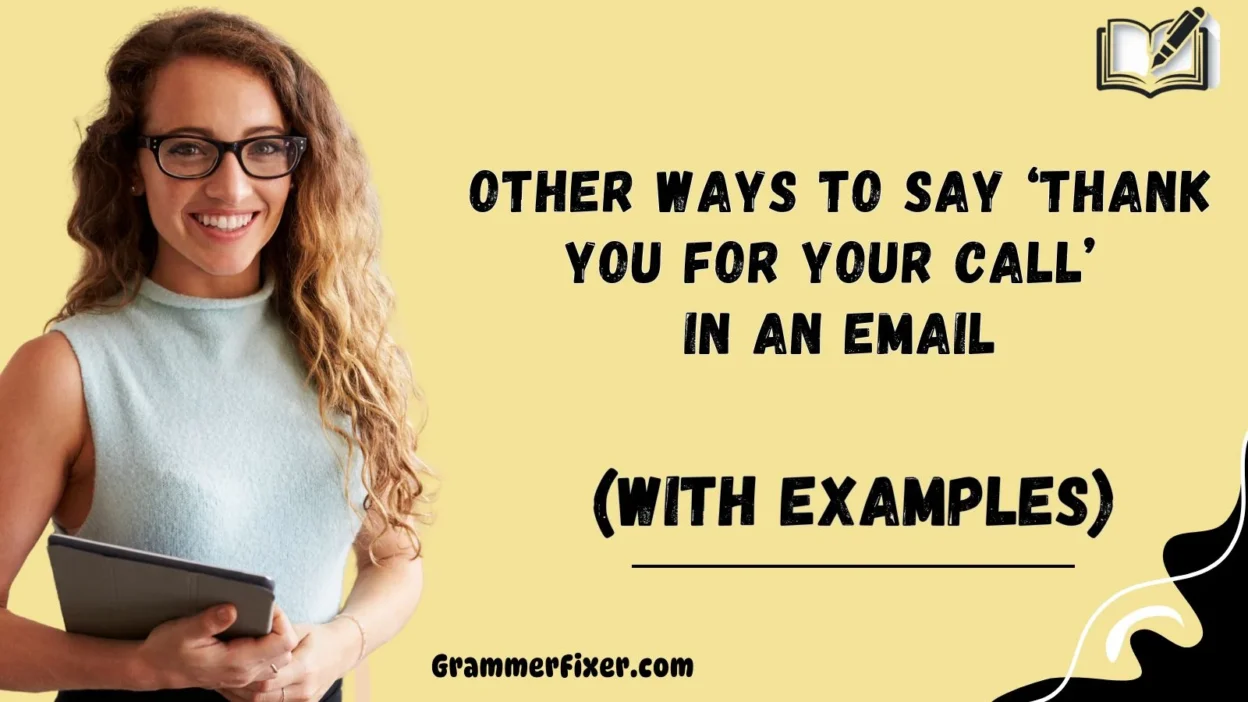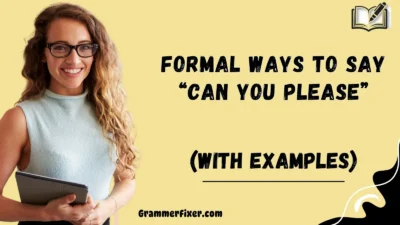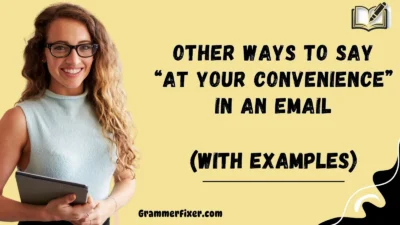Finding the right words in an email can make a world of difference. A simple phrase like “Thank you for your call” shows respect, but when expressed with more warmth and personalization, it can strengthen connections, demonstrate professionalism, and make people feel valued.
Below, we’ll explore 30 thoughtful alternatives, each with examples and best-use cases to help you write emails that leave a meaningful impact.
What Does “Thank You for Your Call” Mean?
Saying “Thank you for your call” is a way to acknowledge the time, effort, and attention someone gave you by calling. It conveys gratitude, shows you value the conversation, and keeps your professional or personal relationship positive.
When to Use “Thank You for Your Call”?
You can use this phrase after:
- Job interviews
- Client calls
- Customer support interactions
- Team discussions
- Follow-ups on projects or issues
It works in professional emails, business correspondence, or casual notes when you want to show respect and keep the relationship warm.
Is It Professional/Polite to Say “Thank You for Your Call”?
Yes—it’s both professional and polite. However, in formal business settings, you may want to customize the phrase to reflect the specific context of the call. Doing so shows attentiveness and thoughtfulness rather than relying on generic wording.
Pros or Cons of Saying “Thank You for Your Call”
Pros:
- Simple and universally understood
- Expresses gratitude clearly
- Works in almost any email setting
Cons:
- May feel generic or overused
- Lacks personalization
- Can come across as insincere if repeated too often
1. I Appreciate You Taking the Time to Speak with Me Today
Meaning: Acknowledges the caller’s effort and time.
Detailed Explanation: Highlights gratitude while recognizing that their time is valuable.
Scenario Example:
“I appreciate you taking the time to speak with me today about the upcoming project. Your insights were invaluable.”
Best Use: Professional, respectful tone when speaking with clients, managers, or colleagues on important topics.
Worst Use: Too formal for casual friends, family, or very brief, informal calls.
Tone: Warm, professional, thoughtful.
2. It Was Great Hearing from You
Meaning: Emphasizes enjoyment of the conversation.
Detailed Explanation: Shows positivity and makes the exchange feel lighthearted and pleasant.
Scenario Example:
“It was great hearing from you earlier this week. I look forward to our continued collaboration.”
Best Use: Semi-casual emails with colleagues, clients, or networking contacts where you want to add friendliness.
Worst Use: In highly formal or serious business discussions (e.g., legal, finance, or compliance contexts).
Tone: Friendly, approachable, engaging.
3. Thank You for Reaching Out
Meaning: Appreciates the initiative someone took to connect.
Detailed Explanation: Recognizes effort and encourages further dialogue, signaling openness.
Scenario Example:
“Thank you for reaching out regarding the new proposal. I’ll review it and get back to you shortly.”
Best Use: Professional settings with clients, potential customers, or business partners.
Worst Use: After a very personal or emotional phone call, where it may sound detached or too corporate.
Tone: Polite, professional, appreciative.
4. I Truly Valued Our Conversation
Meaning: Communicates deep appreciation for the discussion.
Detailed Explanation: Adds emotional depth and emphasizes the importance of the conversation.
Scenario Example:
“I truly valued our conversation about the product updates. Your perspective gave me a clearer direction.”
Best Use: When you want to build stronger rapport in professional or mentorship relationships.
Worst Use: For a very short or routine call where the phrase may feel exaggerated or insincere.
Tone: Sincere, thoughtful, warm.
5. I’m Grateful We Had the Chance to Connect
Meaning: Expresses gratitude for the opportunity to engage.
Detailed Explanation: This phrase shows appreciation for the connection itself, not just the call, emphasizing relationship-building.
Scenario Example:
“I’m grateful we had the chance to connect today and discuss your team’s upcoming initiatives.”
Best Use: Networking, client relationship-building, or when nurturing professional partnerships.
Worst Use: In routine workplace check-ins where “grateful” feels too heavy.
Tone: Appreciative, relational, warm.
6. I Sincerely Appreciate Your Call
Meaning: Directly conveys genuine gratitude.
Detailed Explanation: The word “sincerely” adds depth and eliminates doubt about your appreciation.
Scenario Example:
“I sincerely appreciate your call yesterday to walk me through the details of the budget plan.”
Best Use: Professional communications where you want to show serious respect for someone’s time.
Worst Use: With friends or casual acquaintances — it may sound overly formal.
Tone: Formal, respectful, genuine.
7. Thanks for Taking the Time to Speak with Me
Meaning: Acknowledges both the effort and time commitment.
Detailed Explanation: Keeps it polite and professional while emphasizing the caller’s investment in the conversation.
Scenario Example:
“Thanks for taking the time to speak with me earlier today about the staffing changes. Your feedback was extremely helpful.”
Best Use: Business conversations, interviews, or client calls where you want to recognize time spent.
Worst Use: Very short or trivial calls (like confirming a lunch order).
Tone: Professional, polite, appreciative.
8. I Appreciated Hearing Your Insights
Meaning: Highlights the value of what was shared during the call.
Detailed Explanation: Instead of focusing on the call itself, it appreciates the substance of the discussion.
Scenario Example:
“I appreciated hearing your insights on streamlining the onboarding process. They will be integral to our planning.”
Best Use: Calls where expertise, advice, or opinions were shared.
Worst Use: Casual or non-substantive conversations — may sound insincere if nothing meaningful was discussed.
Tone: Respectful, intellectual, professional.
9. It Was a Pleasure Speaking with You
Meaning: Expresses enjoyment and appreciation simultaneously.
Detailed Explanation: A versatile phrase that combines gratitude, warmth, and professionalism.
Scenario Example:
“It was a pleasure speaking with you this morning about the upcoming collaboration. I look forward to the next steps.”
Best Use: Suitable for formal or semi-formal conversations with clients, partners, or senior leaders.
Worst Use: Casual conversations with close friends or peers — might come off stiff or unnatural.
Tone: Polite, professional, pleasant.
10. I’m Glad You Called
Meaning: Simple acknowledgment of the value of the call.
Detailed Explanation: Expresses personal appreciation and a touch of friendliness without being too formal.
Scenario Example:
“I’m glad you called to share updates about the project. It helped me get a clearer perspective.”
Best Use: Casual or semi-professional calls where you want to sound approachable.
Worst Use: Serious business contexts where a more formal acknowledgment is expected.
Tone: Warm, casual, conversational.
11. Thank You for Taking the Time to Call
Meaning: Highlights both gratitude and recognition of someone’s effort.
Detailed Explanation: Shows that you value not only the conversation but also the time and consideration the caller dedicated.
Scenario Example:
“Thank you for taking the time to call and walk me through your suggestions. They’ll be really helpful for our next steps.”
Best Use: Professional exchanges where you want to stress time investment.
Worst Use: Informal or personal calls — may sound too rigid for friends or casual chats.
Tone: Formal, respectful, considerate.
12. I Truly Appreciate Your Input
Meaning: Emphasizes gratitude for the caller’s ideas and perspective.
Detailed Explanation: This phrase values what they shared, not just the call itself.
Scenario Example:
“I truly appreciate your input on the marketing strategy during our call earlier. It gave us new direction.”
Best Use: When receiving advice, feedback, or expertise.
Worst Use: For generic or logistical calls — could feel exaggerated.
Tone: Thoughtful, respectful, professional.
13. Thank You for Sharing Your Thoughts
Meaning: Recognizes the caller’s contribution to the discussion.
Detailed Explanation: Keeps the tone collaborative, showing that you value open dialogue.
Scenario Example:
“Thank you for sharing your thoughts on the customer feedback results. It will help us refine our approach.”
Best Use: Team discussions, client input, or project brainstorming.
Worst Use: Short calls with little substance — may sound forced.
Tone: Collaborative, warm, professional.
14. I’m Thankful for the Opportunity to Speak with You
Meaning: Expresses gratitude for the chance to connect.
Detailed Explanation: Goes beyond the call itself, showing appreciation for the relationship and opportunity.
Scenario Example:
“I’m thankful for the opportunity to speak with you about the partnership plans. It was both insightful and productive.”
Best Use: Networking, interviews, or high-value client conversations.
Worst Use: Everyday work calls where it might sound too weighty.
Tone: Formal, grateful, sincere.
15. Thank You for Reaching Me Today
Meaning: Appreciates the effort made to connect directly.
Detailed Explanation: Slightly different from “reaching out,” this phrase stresses the personal connection made during the call.
Scenario Example:
“Thank you for reaching me today to clarify the details of the schedule. It really helped avoid confusion.”
Best Use: When someone went out of their way to ensure communication.
Worst Use: Overly formal settings — it may sound casual or imprecise.
Tone: Friendly, approachable, conversational.
16. I Appreciate the Opportunity to Discuss This with You
Meaning: Highlights gratitude for both the call and the subject matter.
Detailed Explanation: Recognizes that the caller gave you a chance to explore something meaningful or important.
Scenario Example:
“I appreciate the opportunity to discuss this with you today. Your insights will be instrumental as we move forward.”
Best Use: Professional settings such as interviews, strategy calls, or client discussions.
Worst Use: Small talk or casual calls where no significant topic was discussed.
Tone: Formal, respectful, professional.
17. I’m Thankful for Your Time and Attention
Meaning: Shows gratitude for the effort and focus someone offered during the call.
Detailed Explanation: Goes beyond acknowledging the call itself and appreciates the person’s attentiveness.
Scenario Example:
“I’m thankful for your time and attention during our discussion about the client’s requirements.”
Best Use: Business or project-related conversations where someone listened and engaged actively.
Worst Use: Casual or personal calls — it may sound stiff and overly formal.
Tone: Polite, formal, appreciative.
18. Thank You for Walking Me Through This
Meaning: Shows appreciation for guidance or explanation given during the call.
Detailed Explanation: Useful when someone explained a process, concept, or situation in detail.
Scenario Example:
“Thank you for walking me through this process today. I feel much more confident about the next steps.”
Best Use: Calls where you received instructions, clarifications, or training.
Worst Use: Networking or casual chats where nothing was explained.
Tone: Respectful, thankful, practical.
19. I Appreciate the Clarity You Provided
Meaning: Thanks the caller for helping you understand better.
Detailed Explanation: Directly acknowledges the value of clear communication received during the call.
Scenario Example:
“I appreciate the clarity you provided in today’s call. It will really help us move the project forward.”
Best Use: Conversations that resolved confusion, answered questions, or gave specific direction.
Worst Use: Short courtesy calls where clarity wasn’t needed.
Tone: Professional, precise, appreciative.
20. Thank You for Helping Me Understand This Better
Meaning: Expresses gratitude for someone’s effort in enhancing your understanding.
Detailed Explanation: A warm and slightly more personal alternative to acknowledging clarity.
Scenario Example:
“Thank you for helping me understand this better. Your explanation about the budget allocations was very clear.”
Best Use: Mentorship, training, or client conversations where education or explanation was given.
Worst Use: High-level professional contexts where overly casual wording may not fit.
Tone: Warm, appreciative, conversational.
21. I’m Grateful for the Chance to Hear Your Perspective
Meaning: Appreciates the caller’s unique viewpoint.
Detailed Explanation: Focuses on the value of ideas shared, showing you genuinely listened.
Scenario Example:
“I’m grateful for the chance to hear your perspective on the new campaign. It helped me see things differently.”
Best Use: Strategic discussions, brainstorming, or feedback sessions.
Worst Use: Simple update or scheduling calls where no perspectives were exchanged.
Tone: Thoughtful, respectful, professional.
22. Thank You for Keeping Me Informed
Meaning: Acknowledges that the caller provided useful updates.
Detailed Explanation: Recognizes the importance of staying in the loop and values the communication.
Scenario Example:
“Thank you for keeping me informed about the changes in the timeline. This helps me plan better.”
Best Use: Project updates, ongoing work discussions, or reporting.
Worst Use: Calls where nothing new was shared.
Tone: Professional, practical, appreciative.
23. I Appreciated the Updates You Shared
Meaning: Thanks the caller for providing recent developments.
Detailed Explanation: Slightly warmer than “keeping informed,” this phrase values the act of sharing.
Scenario Example:
“I appreciated the updates you shared during our call. It gave me a clearer picture of where things stand.”
Best Use: Team updates, client check-ins, or reporting situations.
Worst Use: Informal chats where updates weren’t the purpose.
Tone: Appreciative, professional, clear.
24. Thank You for Bringing This to My Attention
Meaning: Expresses gratitude for being alerted to an issue or opportunity.
Detailed Explanation: Useful when someone flagged something important that might have otherwise been overlooked.
Scenario Example:
“Thank you for bringing this to my attention during our call. I’ll make sure it’s addressed right away.”
Best Use: Problem-solving, issue reporting, or risk management.
Worst Use: General networking or relationship calls — may sound impersonal.
Tone: Professional, attentive, solution-focused.
25. I’m Thankful for Your Guidance
Meaning: Acknowledges advice, direction, or mentorship.
Detailed Explanation: Strongly emphasizes gratitude for leadership or mentoring.
Scenario Example:
“I’m thankful for your guidance in today’s call. Your advice will be invaluable as I move forward.”
Best Use: Mentor-mentee relationships, career discussions, or leadership calls.
Worst Use: Routine updates where no guidance was given.
Tone: Respectful, warm, sincere.
26. Thank You for Explaining That So Clearly
Meaning: Gratitude for a clear and thorough explanation.
Detailed Explanation: Recognizes the caller’s communication skills and effort in making something understandable.
Scenario Example:
“Thank you for explaining that so clearly during our call. It made the entire process much easier to follow.”
Best Use: Instructional calls, client onboarding, or technical explanations.
Worst Use: Informal or casual calls without technical detail.
Tone: Appreciative, respectful, practical.
27. I’m Grateful for the Insights You Shared
Meaning: Shows deep gratitude for knowledge and perspective gained.
Detailed Explanation: Frames the caller’s contribution as valuable insights, not just general feedback.
Scenario Example:
“I’m grateful for the insights you shared today about customer engagement. They’ll shape how we approach the rollout.”
Best Use: Professional discussions that yield meaningful takeaways.
Worst Use: Short, logistical calls where no real insights were exchanged.
Tone: Professional, thoughtful, warm.
28. Thank You for the Productive Conversation
Meaning: Acknowledges that the call was efficient and meaningful.
Detailed Explanation: Values the results of the conversation, not just the act of having it.
Scenario Example:
“Thank you for the productive conversation about the Q4 targets. I feel confident about the next steps.”
Best Use: Project planning, business strategy, or client meetings.
Worst Use: Casual catch-ups or purely social calls.
Tone: Professional, results-oriented, respectful.
29. I Appreciated Your Time and Contribution
Meaning: Recognizes both the effort and value added by the caller.
Detailed Explanation: Goes beyond thanking for presence, highlighting active participation.
Scenario Example:
“I appreciated your time and contribution during our call today. Your input will help strengthen the proposal.”
Best Use: Team collaborations, stakeholder meetings, or client calls.
Worst Use: Casual check-ins where the word “contribution” feels too heavy.
Tone: Respectful, professional, appreciative.
30. It Meant a Lot to Speak with You
Meaning: Shows emotional appreciation and adds warmth.
Detailed Explanation: A more personal, heartfelt alternative to a standard thank-you.
Scenario Example:
“It meant a lot to speak with you today. I truly value the relationship we’ve built.”
Best Use: Relationship-building calls, supportive conversations, or personal-professional hybrid contexts.
Worst Use: Strictly formal business calls where emotion might feel out of place.
Tone: Warm, heartfelt, genuine.
Conclusion
Finding the right words to say “thank you for your call” in an email can transform a simple courtesy into a genuine gesture of appreciation. By choosing alternatives that highlight time, input, clarity, or connection, you not only show respect but also strengthen relationships and leave a more meaningful impression. The key is to match your tone with the context—whether formal, professional, or warm and personal—so your message feels authentic rather than generic. With these 30 thoughtful variations, you can express gratitude in ways that feel sincere, memorable, and aligned with your relationship with the recipient.



